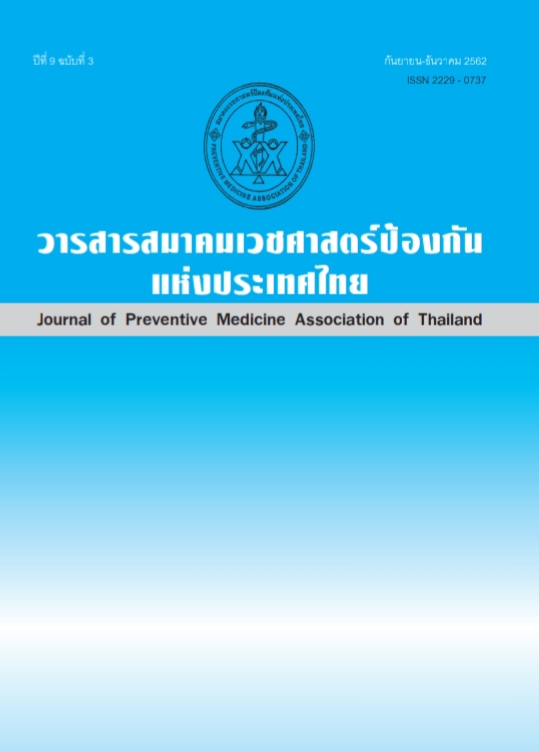The Results from the Implementation of the Program for Hemiplegia Patients to Rehabilitate Their Hands and Arms for use in Daily Activities
Keywords:
Rehabilitate hands and arms program, Daily activities, Hemiplegia PatientsAbstract
Patients suffering from Hemiplegia are physically and motionally impaired which in turn creates considerable issues in many activities Since they are not physically mobile as they were in the past, the ability is complete daily activities is greatly reduced. Nurses, therefore, have a major role in assisting patients with hemiparesis in performing their daily activities. This single group experimental research measures the results both before and after the experiment is concluded. The objective of this research is to compare the scores of hemiplegia patients in performing daily activities before and after completing a program to rehabilitate their hands and arms. The sample group was selected by specific sampling. This group consists of 30 hemiplegia patients resting in the area of Bang Pa-in Hospital in the Phra Nakhon Si Ayutthaya province. The sample group participated in four week rehabilitation program. The tools used were a lesson plan for the rehabilitation program for hands and arms in hemiplegia patients with a content validity of 0.82 and an assessment form concerning the ability to complete daily activities. The tools have a reliability of 0.84. The statistical tools used are frequency, percentage, average, and standard deviation. A comparison was concluded by comparing the scores of hemiplegia patients according to their ability to complete daily activities before and after the completion of rehabilitation program for hands and arms. A paired t-test was used in analysis when repeated measures ANOVA with a significance of 0.05. The results found that the 30 hemiplegia patients who
participated in the rehabilitation program for their hands and arms had higher average scores after participation in the program. Week I [The differences of the average=0.47, 95% CI=0.25-0.68, p-value<0.001] Week II [The differences of the average=2.10, 95% CI=1.68-2.52, p-value<0.001] Week III [The differences of the average=3.77, 95% CI=3.22-4.31, p-value<0.001] and Week IV [The differences of the average=4.33, 95% CI=3.82-4.84, p-value<0.001]. The trend of the program for the rehabilitation increases the scores of their ability to complete daily activities requiring the use of hands and arms of hemiplegia patients. As such, the increase in the score of their ability to complete daily activities requiring hands and arms of hemiplegia patients is not mainly caused by one single factor. Therefore, the program for the rehabilitation of hands and arms of hemiplegia patients should be researched further and applied to the nursing care of the aforementioned patients to support their daily activities.
References
2. กรมควบคุมโรค กระทรวงสาธารณสุข. รายงานประจำปี สำนักโรคไม่ติดต่อ 2560 [อินเทอร์เน็ต]. 2560 [เข้าถึงเมื่อ 18 เม.ย. 2562]. เข้าถึงได้จาก: http://www.thaincd.com/2016/media-detail.php?id=12986&tid=30&gid=1-015-008.
3. กรมสุขภาพจิต กระทรวงสาธารณสุข. แนวทางการดูแลผู้ป่วยอัมพาตครึ่งซีกจากโรคหลอดเลือดสมอง (Hemiplegic Stroke) แบบผสมผสาน [อินเทอร์เน็ต]. 2553 [เข้าถึงเมื่อ 23 เม.ย. 2562]. เข้าถึงได้จาก:https://www.km.dmh.go.th/asset/view.asp?id=37
4. โรงพยาบาลบางปะอิน. สถิติผู้ป่วยโรคหลอดเลือดสมอง. พระนครศรีอยุธยา:ฝ่ายเวชระเบียน โรงพยาบาลบางปะอิน สำนักงานสาธารณสุขจังหวัดพระนครศรีอยุธยา; 2562.
5. Fisher WA, Fisher JD, Harman, J. The information-motivation-behavioral skills model: A general social psychological approach to understanding and promoting health behavior. Malden: Blackwell; 2003. p.82-106.
6. บุญชม ศรีสะอาด. หลักการวิจัยเบื้องต้น. พิมพ์ครั้งที่ 3. กรุงเทพฯ:สุวีริยาสาสน์; 2535.
7. สุทธิชัย จิตะพันธ์กุล. การวิเคราะห์ผู้สูงอายุ หลักสำคัญของเวชศาสตร์ผู้สูงอายุ. พิมพ์ครั้งที่ 2. กรุงเทพฯ: โรงพิมพ์แห่งจุฬาลงกรณ์มหาวิทยาลัย; 2541: หน้า 85-6.
8. เดือนเพ็ญ ตั้งเมตตาจิตตกุล. ผลของโปรแกรมการให้ข้อมูล การสร้างแรงจูงใจและการพัฒนาทักษะความร่วมมือในการรักษาของผู้สูงอายุโรคต้อหิน. [วิทยานิพนธ์ปริญญาพยาบาลศาสตรมหาบัณฑิต]. กรุงเทพฯ:จุฬาลงกรณ์มหาวิทยาลัย; 2554.
9. อุ่นเรือน ศรอากาศ. ปัจจัยที่มีอิทธิพลต่อพฤติกรรมการฟื้นฟูสมรรถภาพผู้ป่วยโรคหลอดเลือดสมองของสมาชิกครอบครัวผู้ดูแล. วารสารวิจัยทางวิทยาศาสตร์สุขภาพ 2558;9:86-93.
10. พัชรินทร์ มาลีหวล. ผลของโปรแกรมการดูแลผู้ป่วยตามปัจจัยสิ่งเร้าและการเสริมสร้างทักษะการฟื้นฟูสภาพผู้ป่วยโดยการมีส่วนร่วมของครอบครัวต่อการปรับตัวของผู้ป่วยอัมพาตท่อนล่าง. [วิทยานิพนธ์ปริญญาพยาบาลศาสตรมหาบัณฑิต]. เชียงใหม่: มหาวิทยาลัยเชียงใหม่; 2551.
11. นันทกา แก้วเฉย. ผลของการฝึกกิจกรรมแบบมอนเตสซอรีต่อแรงบีบมือและความหวังของผู้ป่วยโรคหลอดเลือดสมอง. [วิทยานิพนธ์ปริญญาวิทยาศาสตรมหาบัณฑิต]. กรุงเทพฯ:จุฬาลงกรณ์มหาวิทยาลัย; 2552.
12. สุจิตรา มหาสุข. ผลของโปรแกรมการให้ข้อมูล การสร้างแรงจูงใจ และการฟื้นฟูมือและแขนต่อความสามารถในการทำกิจวัตรประจำวันของผู้สูงอายุโรคหลอดเลือดสมอง. [วิทยานิพนธ์ปริญญาพยาบาลศาสตรมหาบัณฑิต]. กรุงเทพฯ:จุฬาลงกรณ์มหาวิทยาลัย; 2560.
Downloads
Published
How to Cite
Issue
Section
License
บทความที่ลงพิมพ์ในวารสารเวชศาสตร์ป้องกันแห่งประเทศไทย ถือเป็นผลงานวิชาการ งานวิจัย วิเคราะห์ วิจารณ์ เป็นความเห็นส่วนตัวของผู้นิพนธ์ กองบรรณาธิการไม่จำเป็นต้องเห็นด้วยเสมอไปและผู้นิพนธ์จะต้องรับผิดชอบต่อบทความของตนเอง






